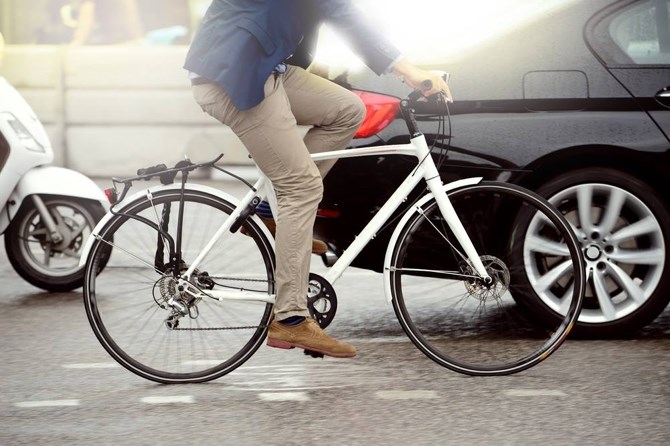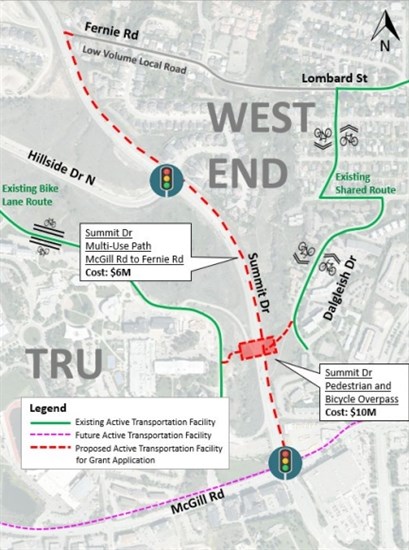
Image Credit: Shutterstock
March 31, 2022 - 7:00 PM
Deb Alore has been bike commuting in Kamloops for decades, but she still has to put her "game face" on every time she gets on the saddle, especially since moving to the south side of the Thompson River.
Alore has lived in a condo on the Thompson Rivers University campus for nearly a year, where she and her husband downsized to from their Brocklehurst home. For the avid and experienced cyclists, however, current roadways and paths to and from campus leave much to be desired.
"TRU is an island and it's missing the key links," Alore said. "It's quite evident that something needs to be done to bridge the moat around the university."
Cycling around the campus can be a breeze, but with wide, busy roadways like Summit Drive and McGill Road bordering the university, Alore has limited, if any, safe bike routes to go to any other neighbourhood. She'll often use the sidewalk to bike in Aberdeen, Dufferin and Lower Sahali, but cyclists are expected to use the road like any other vehicle.
"At one point in my experience, I realized losing my life would only inch promotion of cycling forward for a couple weeks," she said.
READ MORE: Two Ukrainian soldiers who received supplies from Kelowna were killed
Although it's challenging, and often dangerous, Alore is hopeful for the upcoming pedestrian and cyclist overpass that will cross Summit Drive. The City plans to build the overpass that will connect the university campus with Dalgleish Drive and west downtown, but it hinges on federal government funding to cover most of the $10 million bill.
After getting approval from Kamloops City council on March 29, staff are applying for a grant that would cover 60% of the overpass project. Most of the $10 million project would go toward the overpass, while the remaining $3.6 million is aimed at a multi-use path that would separate pedestrians and cyclists from the road between McGill and Fernie roads.
With 60% of the project to be potentially funded by the federal government and another 20% by the university, City planners can still use its active transport budget for other projects in the works for cyclists.
Staff recommended that if the federal government does not approve the grant funding, the City and university should split the cost 50-50, but that received pushback from some councillors.
READ MORE: Planned political rally at Kamloops city hall derailed by anti-vaxxers
"The concerns I have here... is I think TRU is going to benefit the most," Coun. Bill Sarai said. "If this doesn't get funded, I don't believe the taxpayers of all of Kamloops would feel comfortable spending money on a project that's going to benefit just one segment of an educational piece that we don't have a lot of residential support."
Despite his support for the project, he suggested the university pay for as much as 80% of the project if the grant funding doesn't come through. He also wasn't alone in that call.
Coun. Mike O'Reilly also voiced concern that more of the cost should be borne by the university, a provincially funded institution, rather than splitting the cost in half.
Chief administrative officer Dave Trawin also told council that while this project may be helpful for mostly university staff and students now, it's part of a larger transportation plan that would eventually connect Sahali and Dufferin to TRU and downtown cycling routes.
READ MORE: Could a tax on million dollar homes help fight B.C.'s housing affordability crunch?
Alore, both an avid cyclist and member of the Kamloops Cycling Coalition, called it shortsighted to be "bogged down" focusing on the cost. She added that the overpass would not only help cyclists get to and from TRU, but it would also remove pedestrians from the McGill Road and Summit Drive intersection, where there is a dangerous goods route and 16,000 drivers per day.
Council ultimately decided that if the grant funding doesn't get approved by the federal government, the overpass would return to council to figure out how the City would fund the project.
The overpass has already been discussed since for at least a decade, when the City commissioned an engineering study for the project in 2012 before it was written into the Transportation Plan in 2018. If all goes as currently planned, the overpass and separated bike lane would be built by 2026.
"I just know that in time, people will be happy about it," Alore said. "The next driver that hits, and even kills, a pedestrian or cyclist at that intersection is going to wish we spent the $10 million."

The proposed overpass and multi-use pathway are shown in this diagram presented to Kamloops City council on March 29.
Image Credit: City of Kamloops
To contact a reporter for this story, email Levi Landry or call 250-819-3723 or email the editor. You can also submit photos, videos or news tips to the newsroom and be entered to win a monthly prize draw.
We welcome your comments and opinions on our stories but play nice. We won't censor or delete comments unless they contain off-topic statements or links, unnecessary vulgarity, false facts, spam or obviously fake profiles. If you have any concerns about what you see in comments, email the editor in the link above.
News from © iNFOnews, 2022